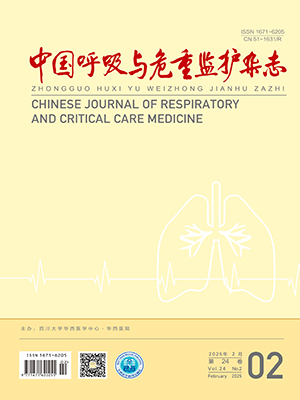| 1. |
Seys SF, Daenen M, Dilissen E, et al. Effects of high altitude and cold air exposure on airway inflammation in patients with asthma. Thorax, 2013, 68(10): 906-913.
|
| 2. |
Ogino K, Nagaoka K, Okuda T, et al. PM2.5-induced airway inflammation and hyperresponsiveness in NC/Nga mice. Environ Toxicol, 2017, 32(3): 1047-1054.
|
| 3. |
Huang SL, Hsu MK, Chan CC. Effects of submicrometer particle compositions on cytokine production and lipid peroxidation of human bronchial epithelial cells. Environ Health Perspect, 2003, 111(4): 478-482.
|
| 4. |
Yang J, Wu HQ, Zhou XD, et al. Cold-inducible RNA-binding protein mediates airway inflammation and mucus hypersecretion through a post-transcriptional regulatory mechanism under cold stress. Int J Biochem Cell Biol, 2016, 78(4): 335-348.
|
| 5. |
De Leeuw F, Zhang T, Wauquier C, et al. The cold-inducible RNA-binding protein migrates from the nucleus to cytoplasmic stress granules by a methylation-dependent mechanism and acts as a translational repressor. Exp Cell Res, 2007, 313(20): 4130-4144.
|
| 6. |
Qiang X, Yang WL, Wu R, et al. Cold-inducible RNA-binding protein (CIRP) triggers inflammatory responses in hemorrhagic shock and sepsis. Nat Med, 2013, 19(11): 1489-1495.
|
| 7. |
刘美花, 周向东, 李琪, 等. 苦味类中药成份藉苦味受体途径对气道炎症过程的遏制效应. 中国免疫学杂志, 2017, 33(9): 1331-1335.
|
| 8. |
Wiesmiller K, Keck T, Leiacker R, et al. Simultaneous in vivo measurements of intranasal air and mucosal temperature. Eur Arch Otorhinolaryngol, 2007, 264(6): 615-619.
|
| 9. |
Lindemann J, Leiacker R, Stehmer V, et al. Intranasal temperature and humidity profile in patients with nasal septal perforation before and after surgical closure. Clin Otolaryngol Allied Sci, 2001, 26(5): 433-437.
|
| 10. |
Lindemann J, Keck T, Scheithauer MO, et al. Nasal mucosal temperature in relation to nasal air-flow as measured by rhinomanometry. Am J Rhinol, 2007, 21(1): 46-49.
|
| 11. |
刘峰, 周向东, 余红梅, 等. Elafin对气道上皮细胞黏蛋白5AC的调节作用. 中国呼吸与危重监护杂志, 2018, 17(3): 296-300.
|
| 12. |
Donaldson GC, Wedzicha JA. The causes and consequences of seasonal variation in COPD exacerbations. Int J Chron Obstruct Pulmon Dis, 2014, 9(1): 1101-1110.
|
| 13. |
Davis MS, Freed AN. Repeated hyperventilation causes peripheral airways inflammation, hyperreactivity, and impaired bronchodilation in dogs. Am J Respir Crit Care Med, 2001, 164(5): 785-789.
|
| 14. |
Niu H, Hu W, Zhang D, et al. Variations of fine particle physiochemical properties during a heavy haze episode in the winter of Beijing. Sci Total Environ, 2016, 571(2): 103-109.
|
| 15. |
Zanobetti A, Franklin M, Koutrakis P, et al. Fine particulate air pollution and its components in association with cause-specific emergency admissions. Environ. Health Glob. Access Sci Source, 2009, 8(1): 58.
|
| 16. |
Lleonart ME. A new generation of proto-oncogenes: cold-inducible RNA binding proteins. Biochim Biophys Acta, 2010, 1805(1): 43-52.
|
| 17. |
Wellmann S, Bührer C, Moderegger E, et al. Oxygen-regulated expression of the RNA-binding proteins RBM3 and CIRP by a HIF-1-independent mechanism. J Cell Sci, 2004, 117(Pt 9): 1785-1794.
|
| 18. |
Yang C, Carrier F. The UV-inducible RNA-binding protein A18 (A18 hnRNP) plays a protective role in the genotoxic stress response. J Biol Chem, 2001, 276(50): 47277-47284.
|
| 19. |
Sheikh MS, Carrier F, Papathanasiou MA, et al. Identification of several human homologs of hamster DNA damage-inducible transcripts. Cloning and characterization of a novel UV-inducible cDNA that codes for a putative RNA-binding protein. J Biol Chem, 1997, 272(42): 26720-26726.
|
| 20. |
Pichon X, Wilson LA, Stoneley M, et al. RNA binding protein/RNA element interactions and the control of translation. Curr Protein Pept Sci, 2012, 13(4): 294-304.
|
| 21. |
Liu J, Xue J, Zhang H, et al. Cloning, expression, and purification of cold inducible RNA-binding protein and its neuroprotective mechanism of action. Brain Res, 2015, 1597(3): 189-195.
|




